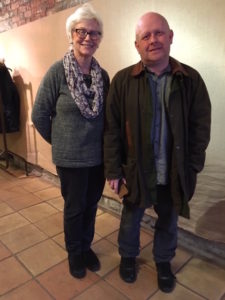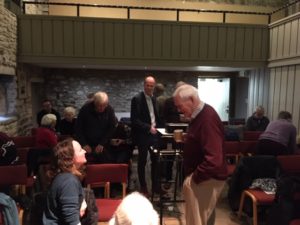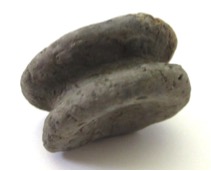Kevin Cootes proved to us that Cheshire was not ‘a black hole’ in the Iron Age nor is it ‘not well known archaeologically’. After outlining nearby settlements, Chester amphitheatre and Meols for example he expanded on the Poulton site. This in an ideal position on a plateau overlooking a rich agricultural flood plain and near to the motorways of history. He riveted our attention on its multi stage occupancy, evidence of Roman habitation and work shops overlying Iron Age roundhouses of which there were plenty.

Prehistory Study Day. Secretary Jean Hardman and speaker Kevin Cootes. Attribution: A Hardman
The site – Chapel Field – was excavated at the request of the farmer who had made an accidental discovery of decorated stone, showing a small mediaeval chapel. Unsurprisingly graves were found but astonishingly these numbered 950 the largest burial excavation in Britain. Roman pottery was found in 14th/15th C. graves which led to an assessment of the landscape which was crammed with gulleys which gave up thousands of Roman finds including industrial waste. Unheard of previously and especially in rural Cheshire. Poulton contains the largest number of Iron Age (IA) roundhouses in lowland NW England in one place, there were ditches, multiple post holes, five thousand finds including lithics. The ditches are very deep 1.5M, 1K plus animal bones were found including traction animals. The cattle and sheep were found to be raised in Poulton. The first antler working was also found here. Roundhouse 3 turned out to be the most intriguing, with two dog burials apparently an IA tradition. A few human bones were also found here as scraps perhaps thrown in with the rubbish. The site was virtually aceramic but one pot containing 10kg salt was found a large amount but useful in preserving food. Industrial waste included iron, copper mould for dress pins, an iron adze was also found which may have been made on the site. Stone tools were also revealed. Kevin outlined the environmental vegetation 45% of this was found in Roundhouse 3 and it possible that this may have been part of a closing down feast. The findings over decades from this fascinating multiperiod site is part of a very vibrant historical story in North West lowland England.

Prehistory Study Day. Sam Walsh chats to Eddie Aldersley. Attribution: A Hardman
Sam Walsh is currently working on remains for Kurdistan from 7,700 years ago. She explained what the study of osteology reveals about past humans such as age at death, sex, health, disease, trauma, burial practices and preservation of bodies. Mostly in the North west people in the BA were cremated. The colour of the bone, fragmentation, size of fragments and fracture patterns all tell the own story. Burials in the BA were commonly in round barrows either singly or in groups, cremation became more common later in the BA where remains were put in urns which were then buried.
Liffs Low and Arbor Low in Derbyshire and Winterbourne near Stoke are well known sites. Cairns were also used such as the one at Whitelow Ramsbottom, where most of the remains have been lost but where there were 12 burials, one in a patterned urn dating 2K to 1700BC. More locally is Carriers Croft at Pendleton excavated by John Hallam in the 60’s and 70’s revealing large fragments of well preserved bone in two urns. In urn three was a gold object the only gold found in Lancashire associated with burials. Other sites where human remains can be found include stake and post hut circles such as at Poulton and the Bleasdale circle and places such as Little Meg and caves such as Fairy Holes that was mentioned by Rick earlier. Other sites in Lancashire include Astley Hall and Bolton-le-Sands. Sam’s fascinating studies revealed that in the EBA grave goods were associated more with women than men and it was women more than men whose remains were represented in Lancashire.

Ear Plug from Whitelow. Attribution: Sam Walsh
Mike Woods interested us with more local sites including Portfield Camp in the Whalley gap. There are two vallates here, its a very difficult site to discern for archaeologists due to the ground being heavily disturbed by the laying of water pipe lines. In 1966 a BA smith’s hoard including two gold items was found. Research in the 1980’s revealed the prescence of post holes suggesting structures inside the fort. It is thought to be late BA early IA. Portfield is on a route way up from Preston along the Ribble to Whalley and also at one end of the Pendle Ridgeway track from Water Meetings at Barrowford to Portfield. Mike outlined the structure of the area of Water meetings revealed by Lidar and geophysics. Both these forts are at either end of the Hidden Valley. Another local hillfort Castercliffe on a prominent site overlooking the Pendle area has three vallates and evidence of vitrification caused by burning, was this done by attackers or was it done by the occupants when they left the site or was it something more mundane? Another local area at Noggarth has some intriguing grey stones that present a ladder boundary and need further investigation.
Last but not least the Chair of Pendle Archaeology Group, Catherine Rousseau Jones outlined the digs on Calf Hill above Sabden and on the flanks of Pendle Hill – not that far from Pendleton. Towards the end of the dig in September evidence of a possible 10 ft diameter circle was discovered and included in finds was a large amount of quartz pebbles which may be significant. Also tantalizingly and found by a metal detectorist was a BA knife, found in the valley overlooked by the site. Intriguing indeed and the planned further excavations will hopefully help to further understanding of prehistory in the area.
What an enjoyable and amazing day this was, interesting, informative, amusing and giving us the knowledge that there are lots of people out there working hard to discover what is in the earth beneath our feet. Their work (and that of others) will further establish the significance of the North West in being a vibrant part of prehistory in the UK and definitely challenges the preconceived idea (dare I say of those southerners) of there being a void in the North West.
With grateful thanks to all these marvellous speakers and the people who worked hard to make the day a success.
We hope to hold another Study day on Pennine Industrialisation – this will now be later in 2020.
Did you know?
80% of IA finds are from Poulton. That the first fish bone from the IA in Central Britain is from Poulton – 798BCk.
The colour of cremated bone attests to pyre efficiency, white bone is the result of temperatures of 600 degrees or more.
Banner Image: Burial Urn. Whitelow. Credit: Sam Walsh